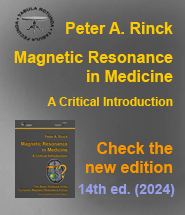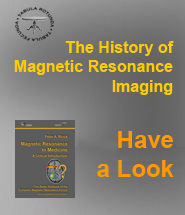Glosario
| a | b | c | d | e | f | g | h | i | j | k | l | m | n | o | p | q | r | s | t | u | v | w | x | y | z |
S
Saddle coil: RF coil configuration design commonly used when the static magnetic field is coaxial with the axis of the coil along the long axis of the body (e.g., superconducting magnets and most resistive magnets) as opposed to solenoid or surface coil.
Saturation: a nonequilibrium state in NMR, in which equal numbers of spins are aligned against and with the magnetic field, so that there is no net magnetization. Can be produced by repeatedly supplying RF pulses at the Larmor frequency with interpulse times short compared to T1.
Saturation recovery (SR): particular type of partial saturation pulse sequence in which the preceding pulses leave the spins in a state of saturation, so that recovery at the time of the next pulse has taken place (→ Partial saturation).
Saturation transfer (or Inversion transfer): nuclei can retain their magnetic orientation through a chemical reaction. Thus, if RF radiation is supplied to the spins at a frequency corresponding to the chemical shift of the nuclei in one chemical state so as to produce saturation or inversion, chemical reactions transform the nuclei into another chemical state with a different chemical shift in a time short compared to the relaxation time. The NMR spectrum may show the effects of the saturation or inversion on the corresponding, unirradiated, line in the spectrum. This technique can be used to study reaction kinetics of suitable molecules.
SE → Spin echo.
Sech pulse → Hyperbolic secant pulse.
Selective excitation controlling the frequency spectrum of an irradiating RF pulse (via tailoring) while imposing a gradient magnetic field on the spins, such that only a desired region will have a suitable resonance frequency for excitation. Originally used to excite all but a desired region; now more commonly used to select only a desired region, such as a plane, for excitation.
Selective irradiation → Selective excitation.
Self refocusing pulse: a category of RF pulses which can be used without a slice refocusing gradient.
Sensitive plane: technique of selecting a plane for sequential plane imaging by using an oscillating gradient magnetic field and filtering out the corresponding time dependent part of the NMR signal. The gradient used is at right angles to the desired plane and the magnitude of the oscillating gradient magnetic field is equal to zero only in the desired plane.
Sensitive point: technique of selecting out a point for sequential point imaging by applying three orthogonal oscillating gradient magnetic fields such that the local magnetic field is time dependent everywhere except at the desired point, and then filtering out the corresponding time dependent portion of the NMR signal.
Sensitive volume: region of the object from which NMR signal will preferentially be acquired because of strong magnetic field inhomogeneity elsewhere. Effect can be enhanced by use of a shaped RF field that is strongest in the sensitive region.
Sensitivity: signal-to-noise ratio (SNR) per unit imaging time [uncommon term; rarely used].
Sequence time → TR.
Sequential line imaging (Line scanning, Line imaging): magnetic resonance imaging techniques in which the image is built up from successive lines through the object. In various schemes, the lines are isolated by oscillating gradient magnetic fields or selective excitation, and then the NMR signals from the selected line are encoded for position by detecting the FID or spin echo in the presence of a gradient magnetic field along the line; the Fourier transform of the detected signal then yields the distribution of emitted NMR signal along the line.
Sequential plane imaging (Plane imaging): magnetic resonance imaging technique in which the image of an object is built up from successive planes in the object. In various schemes, the planes are selected by oscillating gradient magnetic fields or selective excitation.
Sequential point imaging (Point scanning): magnetic resonance imaging techniques in which the image is built from successive point positions in the object. In various schemes, the points are isolated by oscillating gradient magnetic fields (sensitive points) or shaped magnetic fields. Now obsolete for imaging (due to poor S/N ratio) but used in localized spectroscopy.
Shielded gradients: a modified gradient system which eliminates eddy current problems.
Shim coils: coils carrying a relatively small current that are used to provide auxiliary magnetic fields in order to compensate for inhomogeneities in the main magnetic field of an NMR system.
Shimming: correction of inhomogeneity of the magnetic field produced by the main magnet of an NMR system due to imperfections in the magnet or the presence of external ferromagnetic objects. Generally carried out by adjusting the current in the shim coils while observing an FID (or the Fourier transformed signal).
SI (International System of Units): the international standard system of physical units and measures.
Signal-to-noise ratio (SNR or S/N ratio): used to describe the relative contributions to a detected signal of the true signal and random superimposed signals ('noise'). One common method to improve (increase) the S/N ratio is to average several measurements of the signal in the knowledge that random contributions will tend to cancel out. The S/N ratio can also be improved by sampling larger volumes (with a corresponding loss of spatial resolution) or, within limits, by increasing the strength of the magnetic field used. S/N will depend on the electrical properties of the sample or patient being studied.
sinc: sin(x)/x
Simultaneous volume imaging —> Volume imaging.
Skin depth: time dependent electromagnetic fields are significantly attenuated by conducting media (including the human body); the skin depth gives a measure of the average depth of penetration of the RF field. It may be a limiting factor in magnetic resonance imaging at very high frequency (high magnetic fields). The skin depth also affects the Q of the coils.
Slice rephasing gradient: gradient magnetic field applied for a brief period after a selective excitation pulse, in the opposite direction to the gradient used for the selective excitation. The result of the gradient reversal is a rephasing of the spins (which are out of phase with each other along the direction of the selection gradient) leading to a greatly improved S/N ratio.
S/N → Signal-to-noise (ratio).
Snapshot FLASH: a rapid FLASH sequence (scan time 200-500 ms) using a low flip angle (~5°) to produce proton density-weighted scans. Contrast can be manipulated by suitable preparation of the magnetization prior to the scan.
SNR → Signal-to-noise ratio.
Software: the set of instructions, or programs, that controls the acitivites of the computer. Programs may be written in machine language (sequence of numbers directly interpretable by the computer), assembly language, or higher level languages. The software includes overall supervising 'executive' programs (including image reconstruction), and display programs.
Solenoid coil: a coil of wire wound in the form of a long cylinder. When a current is passed through the coil, the magnetic field within the coil is relatively uniform. Solenoid RF coils are commonly used when the static magnetic field is perpendicular to the long axis of the body.
Spectrometer: the portions of the NMR apparatus that actually produce the NMR phenomenon and acquire the signals, including the magnet, the probe, the RF circuitry, etc. The spectrometer is controlled by the computer via the interface under the direction of the software.
Spectrum: an array of the frequency components of the NMR signal according to frequency. Nuclei with different resonance frequencies will show up as peaks at different corresponding frequencies in the spectrum, or 'lines'.
Spin: the intrinsic angular momentum of an elementary particle, or system of particles such as nucleus, that is also responsible for the magnetic moment; or, a particle or nucleus possessing such a spin. The spins of nuclei have characteristic fixed values. Pairs of neutrons and protons align to cancel out their spins, so that nuclei with an odd number of neutrons and/or protons will have a net non-zero rotational component characterized by a non-zero quantum nuclear spin number.
Spin density (ρ, rho, or N): the density of resonating spins in a given region; one of the principal determinants of the strength of the NMR signal from the region. Strictly defined to be the amount of hydrogen per unit volume; the SI units would be moles/m³. For water, there are about 1.1 × 105 moles of hydrogen per m³, or 0.11 moles of hydrogen/cm³. Spin density changes very little between many biological tissues and pathologies leading to images with poor contrast.
Spin echo: (SE); reappearance of an NMR signal after the FID has died away, as a result of the effective reversal of the dephasing of the spins (‘refocusing’) by the application of a refocusing RF pulse (applied in a time shorter than or in the order of T2). Multiple spin echoes or a series of spin echoes at different times can be used to determine T2 without contamination by effects of the inhomogeneity or diffusion.
Spin echo imaging: any of many magnetic resonance imaging techniques in which the spin echo NMR signal rather than the FID is used. Can be used to create images that depend strongly on T2. Note that spin echoes do not directly produce an image of T2, but rather (with long echo times) a T2-weighted image.
Spin-lattice relaxation time → T1.
Spin locking: if one applies a long lasting B1 magnetic field immediately after a 90° pulse, the dephasing of the spins in the x-y plane is stopped while the B1 field is on. This is called spin-locking and the B1 field is called a spin-locking pulse even though it may last hundreds of milliseconds.
Spin number → Nuclear spin number.
Spin-spin relaxation time → T2.
Spin tagging: nuclei will retain their magnetic orientation for a time in the order of T1 even in the presence of motion. Thus, if the nuclei in a given region have their spin orientation changed, the altered spins will serve as a 'tag' to trace the motion of any fluid that may have been in the tagged region for a time on the order of T1.
Spin warp imaging: a form of Fourier transform imaging in which phase encoding gradient pulses are applied for constant duration but with varying amplitude. This is a distinct form of the original FT imaging methods in which phase encoding is performed by applying gradient pulses of constant amplitude but varying duration. The spin warp method is relatively tolerant of non-uniformities (inhomogeneities) in the static or gradient magnetic fields.
Spoiled FLASH: a FLASH sequence with a short TR in which the transverse coherences are removed by the application of one or more spoiler gradients.
Spoiler gradient: a gradient of sufficient amplitude and/or duration to fully dephase a signal. Often placed symmetrically about refocusing pulses so that they have no effect on the refocused signal but eliminate any signal originating at the refocusing pulse.
SR → Saturation recovery.
SSFP → Steady state free precession.
Steady state free precession (SSFP): method of NMR excitation in which strings of RF pulses are applied rapidly and repeatedly with interpulse intervals short compared to T2. This allows transverse coherences to develop which act to reinforce the fresh transverse magnetization generated at each RF pulse. Fourier SSFP imaging sequences require the use of a phase rewinder gradient.
STEAM (Stimulated Echo Acquisition Mode): imaging and localization sequences utilizing a stimulated echo.
Stimulated echo: one of five echoes generated by a sequence of three RF pulses. The signal is stored as longitudinal magnetization between the second and third RF pulse and hence has a signal intensity which depends both on T1 and T2. The maximum intensity of a stimulated echo is only half that of an equivalent spin echo.
STIR (Short TI Inversion Recovery): inversion recovery sequence with a short TI interval.
Superconducting magnet: a magnet whose magnetic field originates from current flowing through a superconductor. Such a magnet must be enclosed in a cryostat.
Superconductor: a substance whose electrical resistance essentially disappears at temperatures near absolute zero. A commonly used superconductor in magnetic resonance imaging system magnets is niobiumtitanium, embedded in a copper matrix to help protect the superconductor from quenching.
Surface coil: a simple flat RF receiver coil placed over a region of interest will have an effective selectivity for a volume which is approximately defined by the coil circumference and extends for one radius deep from the coil center. Some additional spatial selectivity can be achieved with gradient magnetic fields. Offers increased sensitivity compared with conventional RF coils but only over a limited volume. Adiabatic pulses can be used to generate uniform flip angles over the whole volume excited by the surface coil, otherwise the flip angle varies with position.
Superparamagnetic: T2 or T2* contrast agents; originally ferromagnetic substances which have a very small size and thus have lost their permanent magnetism. Also known as bulk susceptibility agents.
Missing terms? Send us an e-mail. We'll add them ...












